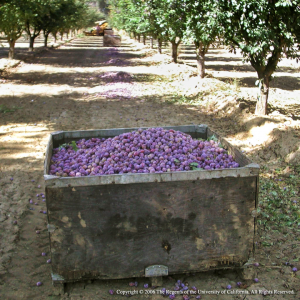Adapted from the articles “When will harvest start in 2011?” by Franz Niederholzer, UC Farm Advisor, Colusa and Sutter/Yuba Counties and Bill Krueger, UC Farm Advisor, Glenn County and “Using Spring Weather Data to Predict Harvest Date for “Improved French” Prune” by Ted DeJong, Pomologist UC Davis, Carolyn DeBuse, UC Farm Advisor, Solano-Yolo Counties, and Gerardo Lopez, IRTA, Lleida, Spain in the Sacramento Valley Prune News, July 2011 and April 2008, respectively
For French prune (as well as peach, Japanese plum, and nectarine) accumulated temperature (growing degree hours or GDH) during the first 30 days after full bloom is closely related to the number of days between full bloom and harvest (Figure 1). This means that fruit maturity date can be predicted by knowing the bloom date and GDH accumulation 30 days after full bloom. This relationship indicates that spring temperatures during the first 30 days after full bloom govern fruit developmental rate and are a major factor in determining the harvest date in any given year. This relationship can be used as an early season tool to estimate the approximate harvest date for Improved French prune.

Harvested prunes.
GDH 30 days after bloom are available at the UC Fruit & Nut Research and Information Center web site. Select the location of the nearest California Irrigation Management Information System (CIMIS) weather station and enter the date of full bloom. The table shows the accumulated GDH during the first 30 days after bloom. With this number, use Figure 1 to determine how many days there will be from full bloom to harvest.
For example, say full bloom were March 18th and the Harvest Prediction Model website said 6000 GDH accumulated in the first 30 days after full bloom. Find 6000 GDH on the bottom axis of Figure 1. 6000 GDH this the trend line at just over 160 days (on the left axis). That would estimate there would be about 160-170 days from full bloom to harvest, placing harvest about the last week of August.
This GDH 30 approach is only an estimate. As the estimated date approaches, it is important to track fruit maturity and target your harvest to deliver the most tonnage when fruit is in the 3-4 pounds pressure range. Fruit maturity must be known and tracked to deliver the best quality, most profitable crop to the dryer. But picking fruit too early leaves money on the table and picking too late leaves money on the orchard floor due to fruit drop and risks delivering poor quality fruit.
Prunes are fully mature and at the highest quality when fruit pressure drops to 3-4 pounds when measured with a pressure tester using a 5/16” diameter plunger tip, available on the internet (e.g. fruittest.com) or through local orchard supply stores. Well maintained prune trees without excessive crop load should reach 24% sugar (soluble solids) at 3-4 pounds pressure. Trees no longer move sugar to the fruit at pressures below 3-4 pounds. Soluble solid content of the fruit may increase due to natural dehydration if the fruit remains on the tree. Soluble solids increase about 2% per week and fruit firmness will drop 1.5 to 2 lbs. per week prior to harvest (more rapidly with cool weather and more slowly with hot weather).
How do you track fruit maturity as harvest approaches? At first fruit color, fruit should be about 10 pounds pressure. Flag 5 sample trees across a block and take 5 pieces of fruit per tree. Sample fruit from inside and outside the canopy as you walk around the tree. Check fruit once a week, using the same trees each week. Sugar or soluble solids can be measured using a refractometer and help with harvest decisions but maturity is most accurately based upon fruit flesh pressure.


Leave a Reply